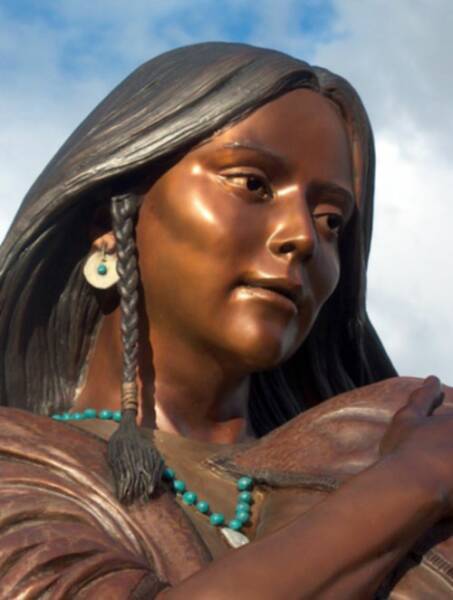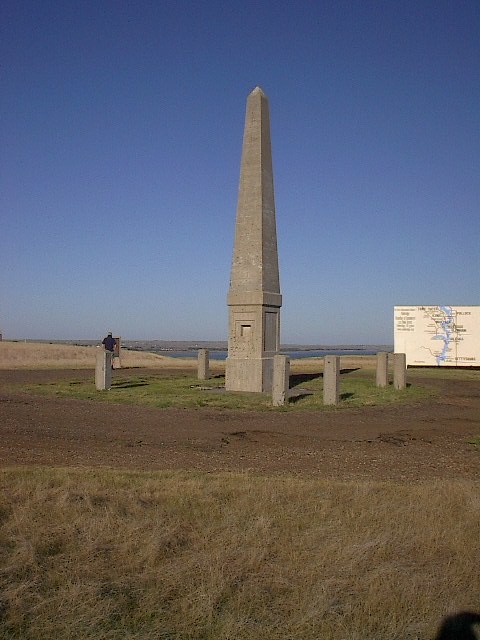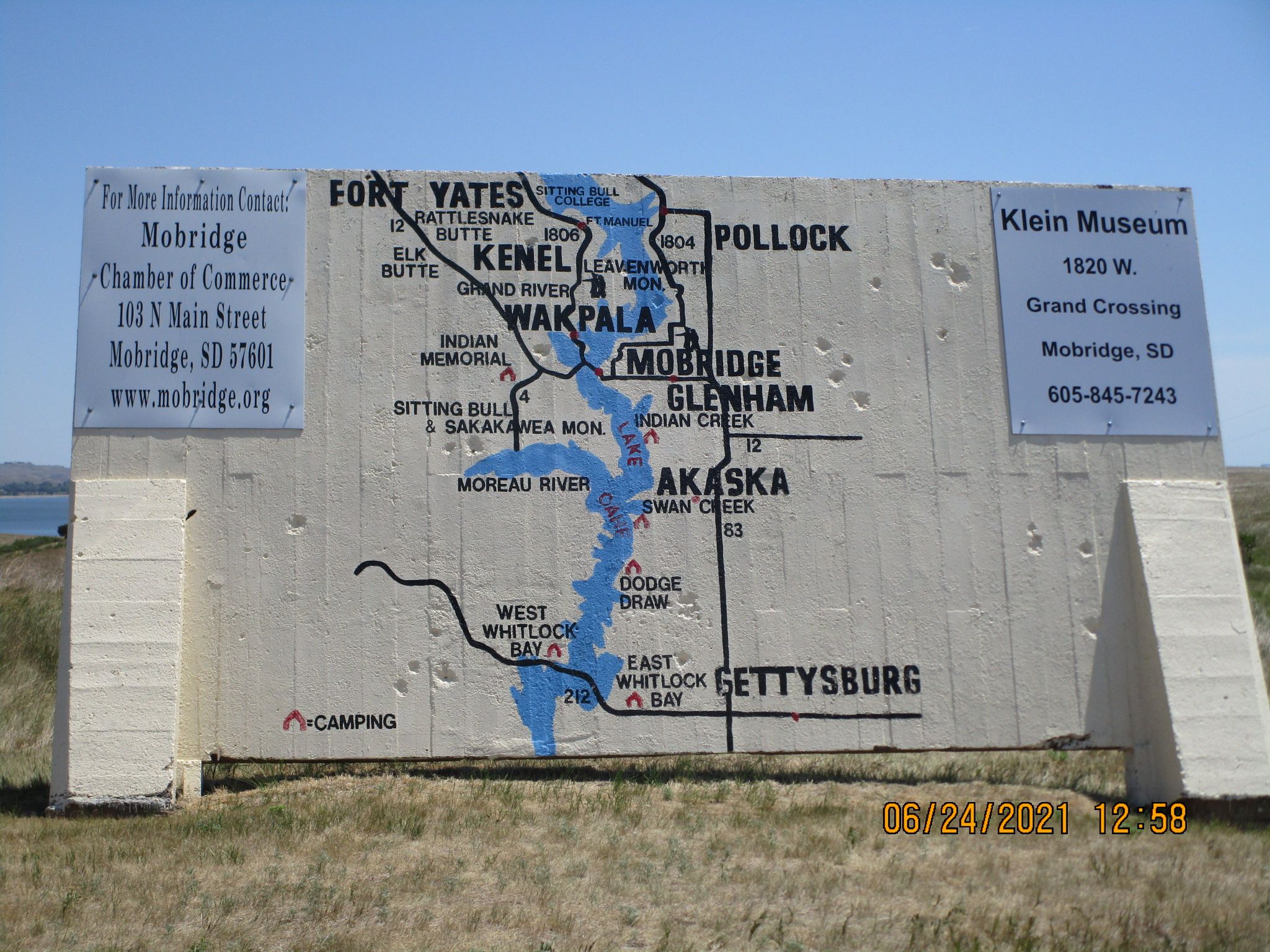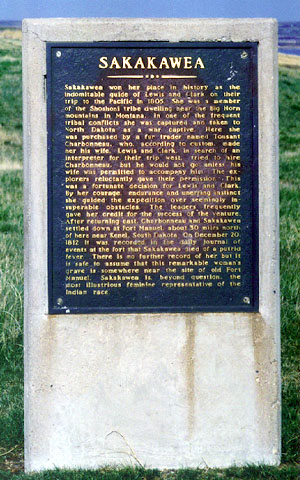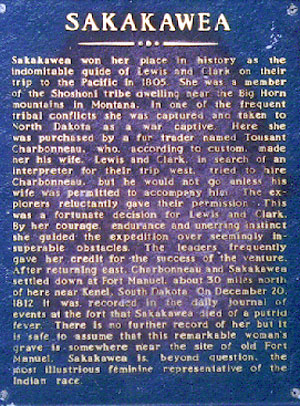Historical Figure. Born to the Lemhi Shoshone people between 1787 and 1789 in what is present-day Idaho. At about age 11 or 12, a Hidatsa raiding party stole her from her home and took her to their territory in present-day North Dakota. By 1804, she was living in a Hidatsa-Mandan settlement when she was taken by a French-Canadian fur trader, Toussaint Charbonneau, as his second wife. In November 1804. The Corps of Discovery, lead by William Clark and Meriwether Lewis, arrived in the village. They recognized the value of Sacajawea and Charbonneau's language skills; Charbonneau spoke French and Hidatsa; Sacajawea spoke Hidatsa and Shoshone, one member of the Corps spoke French and English, and the rest spoke only English. Two months before the group set off, Sacajawea gave birth to a son, Jean Baptiste, whom she would carry throughout the journey. The Corps leaders saw the inclusion of a woman and a child as a clear signal to unknown tribes that they meant no harm. Only a month into the journey, she proved her worth by remaining calm and rescuing important papers, instruments, medicine, and other irreplaceable items that otherwise would have been lost during a boat accident. Lewis and Clark then named a tributary of the Mussellshell River "Sah-ca-gah-weah" after her. When the group finally encountered the Shoshone near Lemhi Pass, she served as translator in trade negotiations, made easier when she recognize the Shoshone leader as her brother. She continued with the Corps to the Pacific coast and was granted an equal vote as to where they should encamp. Often incorrectly described as a guide for the Corps, she did serve as interpreter, peace token, and naturalist, identifying roots, plants, and berries that were either edible or medicinal. She remained with the Corps on their return journey, leaving them at her starting point on August 14, 1806. She and her family traveled to St. Louis in 1809, and left Jean Baptiste in the care of William Clark, who had offered to provide him with an education. Sacajawea and Charbonneau left town in April 1811 to join a fur-trading expedition when she was described as: "...a good creature, of a mild and gentle disposition... but she had become sickly, and longed to revisit her native country," by Henry Brackenridge who chronicled the trading voyage. She gave birth to a daughter, Lisette, in 1812 at Fort Manuel along the Missouri River. A clerk at the fort, John C. Luttig, noted that on December 20, 1812, "This evening the wife of Charbonneau... died of putrid fever. She was good and the best woman in the fort, aged about twenty-five years." Although alternate fates for Sacajawea have been proposed, modern scholarship regards this record as the best historical evidence of her death, especially considering William Clark confirmed it in his list of Corps of Discovery members in 1825. Clark remained Jean Baptiste's guardian and also took Lisette as his ward. He was legally made the guardian of the children in Orphan's Court in August 1813. Sacajawea has since been memorialized with countless statues and monuments, on postal stamps, and in place-names. In 2000, her likeness appeared on a dollar coin struck by the U.S. Mint. In 2001, the US President granted her a posthumous decoration as an honorary Sergeant in the Regular Army. Her name has been variously recorded as Sacajawea, Sacagawea, and Sakakawea.
Historical Figure. Born to the Lemhi Shoshone people between 1787 and 1789 in what is present-day Idaho. At about age 11 or 12, a Hidatsa raiding party stole her from her home and took her to their territory in present-day North Dakota. By 1804, she was living in a Hidatsa-Mandan settlement when she was taken by a French-Canadian fur trader, Toussaint Charbonneau, as his second wife. In November 1804. The Corps of Discovery, lead by William Clark and Meriwether Lewis, arrived in the village. They recognized the value of Sacajawea and Charbonneau's language skills; Charbonneau spoke French and Hidatsa; Sacajawea spoke Hidatsa and Shoshone, one member of the Corps spoke French and English, and the rest spoke only English. Two months before the group set off, Sacajawea gave birth to a son, Jean Baptiste, whom she would carry throughout the journey. The Corps leaders saw the inclusion of a woman and a child as a clear signal to unknown tribes that they meant no harm. Only a month into the journey, she proved her worth by remaining calm and rescuing important papers, instruments, medicine, and other irreplaceable items that otherwise would have been lost during a boat accident. Lewis and Clark then named a tributary of the Mussellshell River "Sah-ca-gah-weah" after her. When the group finally encountered the Shoshone near Lemhi Pass, she served as translator in trade negotiations, made easier when she recognize the Shoshone leader as her brother. She continued with the Corps to the Pacific coast and was granted an equal vote as to where they should encamp. Often incorrectly described as a guide for the Corps, she did serve as interpreter, peace token, and naturalist, identifying roots, plants, and berries that were either edible or medicinal. She remained with the Corps on their return journey, leaving them at her starting point on August 14, 1806. She and her family traveled to St. Louis in 1809, and left Jean Baptiste in the care of William Clark, who had offered to provide him with an education. Sacajawea and Charbonneau left town in April 1811 to join a fur-trading expedition when she was described as: "...a good creature, of a mild and gentle disposition... but she had become sickly, and longed to revisit her native country," by Henry Brackenridge who chronicled the trading voyage. She gave birth to a daughter, Lisette, in 1812 at Fort Manuel along the Missouri River. A clerk at the fort, John C. Luttig, noted that on December 20, 1812, "This evening the wife of Charbonneau... died of putrid fever. She was good and the best woman in the fort, aged about twenty-five years." Although alternate fates for Sacajawea have been proposed, modern scholarship regards this record as the best historical evidence of her death, especially considering William Clark confirmed it in his list of Corps of Discovery members in 1825. Clark remained Jean Baptiste's guardian and also took Lisette as his ward. He was legally made the guardian of the children in Orphan's Court in August 1813. Sacajawea has since been memorialized with countless statues and monuments, on postal stamps, and in place-names. In 2000, her likeness appeared on a dollar coin struck by the U.S. Mint. In 2001, the US President granted her a posthumous decoration as an honorary Sergeant in the Regular Army. Her name has been variously recorded as Sacajawea, Sacagawea, and Sakakawea.
Bio by: Iola
Family Members
Advertisement





